
The "Birds of Winter" are a great way to get through a long winter. Keeping various kinds of feeders filled with sunflower seeds, thistle, small mixed seeds, and of course suet cakes will attract lots of birds that keep me (and the cat) company while we wait for spring. And a great way to help birds besides feeding and watering them is to count them. The Great Back Yard Bird Count is held each year in February. It is conducted by the Cornell Lab of Ornithology and the Audubon Society, and sponsered by Wild Birds Unlimited.  All information gathered is reported by volunteer individuals, such as myself, and reported via the internet. The purpose? To see which species have increased and which have declined, which have kept to their current range, and which have migrated to new areas. It is a fun way to help with research that no one could afford to pay for, but the rewards of doing the count and helping with the research is beyond measure. And, if you want to know what my family's results of the bird count were, click here for the list! All information gathered is reported by volunteer individuals, such as myself, and reported via the internet. The purpose? To see which species have increased and which have declined, which have kept to their current range, and which have migrated to new areas. It is a fun way to help with research that no one could afford to pay for, but the rewards of doing the count and helping with the research is beyond measure. And, if you want to know what my family's results of the bird count were, click here for the list!
The Black-capped Chickadee (Poecile atricapilla) is one of the most familiar birds found at the feeder. They are generally about 5.25" in length and are found here year round. When they visit they almost always are accompanied by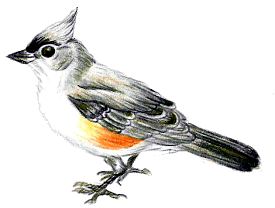 the Tufted Titmouse (Baeolophus bicolor). The Tufted Titlouse is a little larger at up to 5.75" in length, and definitely braver in flying close up to the door of the house to get the peanuts that I throw on the deck. They have very large and expressive (my opinion) eyes. They are also found here year round, and are a relative of the Chickadee. the Tufted Titmouse (Baeolophus bicolor). The Tufted Titlouse is a little larger at up to 5.75" in length, and definitely braver in flying close up to the door of the house to get the peanuts that I throw on the deck. They have very large and expressive (my opinion) eyes. They are also found here year round, and are a relative of the Chickadee.
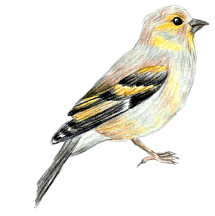 The American Goldfinch (Carduelis tristis) is found here year round, but tends to stay at the feeders more in the winter time. I only see them occasionally in the summer. They are the largest goldfinch (up to 5" in length), but are still a very small bird. This picture shows a winter time female, so she is not very yellow. The males in winter are also very olive to brownish in color and do not have their familiar "black cap". The American Goldfinch (Carduelis tristis) is found here year round, but tends to stay at the feeders more in the winter time. I only see them occasionally in the summer. They are the largest goldfinch (up to 5" in length), but are still a very small bird. This picture shows a winter time female, so she is not very yellow. The males in winter are also very olive to brownish in color and do not have their familiar "black cap".
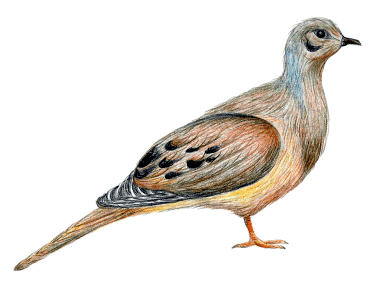 The Mourning Dove (Zenaida macroura) is found almost everyday here, feeding on the ground. They are up to 12" in length and their wings produce a light whistling noise on takeoff. The male and female share incubating duties, with the male sitting much of the day and the female during the night. The Mourning Dove (Zenaida macroura) is found almost everyday here, feeding on the ground. They are up to 12" in length and their wings produce a light whistling noise on takeoff. The male and female share incubating duties, with the male sitting much of the day and the female during the night.
The Red-bellied Woodpecker (Melanerpes carolinus) is a favorite winter-time vistor to the suet feeder. Though it is found in this area year round, it isn't seen very often in the summer months.
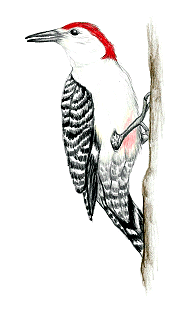 Mainly because it eats insects that are easier to find in the warm months, and secondly because they are hard to spot with all the leaves back on the trees. It is about 9.25" in length. The name is somewhat misleading since the "red belly" is very faint, but the red head is very distinctive. They are hesitant to come up to the suet feeder when I am outside, but not so hesitant in being "loud and noisy" to let me know their displeasure. I got the point and went inside. Mainly because it eats insects that are easier to find in the warm months, and secondly because they are hard to spot with all the leaves back on the trees. It is about 9.25" in length. The name is somewhat misleading since the "red belly" is very faint, but the red head is very distinctive. They are hesitant to come up to the suet feeder when I am outside, but not so hesitant in being "loud and noisy" to let me know their displeasure. I got the point and went inside.
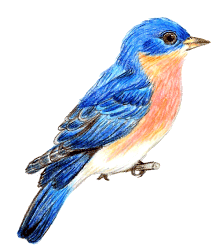 The Eastern Bluebird (Sialia sialis) starts to scope out the best nesting places in winter. And hopefully we will have baby Bluebirds in the spring. They like the Bluebird house we put up or a natural "cavity" in a tree. They are about 7 " in length and are a very cheerful bird to me. They do very well with bluebird houses put out for them, especially if the houses are next to an open area or field. But I have noticed that as soon as the Bluebirds begin to take an interest in the Bluebird house, the Chickadees and Titmice also get interested in the same house. The Eastern Bluebird (Sialia sialis) starts to scope out the best nesting places in winter. And hopefully we will have baby Bluebirds in the spring. They like the Bluebird house we put up or a natural "cavity" in a tree. They are about 7 " in length and are a very cheerful bird to me. They do very well with bluebird houses put out for them, especially if the houses are next to an open area or field. But I have noticed that as soon as the Bluebirds begin to take an interest in the Bluebird house, the Chickadees and Titmice also get interested in the same house.
I think I could keep on going with the birds here, but had better stop. I know this page will take forever to load. I just wanted to mention some of the other "Birds of Winter" that visit here, and they are: Dark-eyed Junco, Downy Woodpecker, Pileated Woodpecker, American Robin, Purple Finch, Northern Cardinal, Blue Jay, White-breasted Nuthatch, Pine Siskin, and the Carolina Wren. There are more, but these are the most common and have helped me to make it until spring. I hope they help you too. |



 All information gathered is reported by volunteer individuals, such as myself, and reported via the internet. The purpose? To see which species have increased and which have declined, which have kept to their current range, and which have migrated to new areas. It is a fun way to help with research that no one could afford to pay for, but the rewards of doing the count and helping with the research is beyond measure. And, if you want to know what my family's results of the bird count were,
All information gathered is reported by volunteer individuals, such as myself, and reported via the internet. The purpose? To see which species have increased and which have declined, which have kept to their current range, and which have migrated to new areas. It is a fun way to help with research that no one could afford to pay for, but the rewards of doing the count and helping with the research is beyond measure. And, if you want to know what my family's results of the bird count were,  the Tufted Titmouse (Baeolophus bicolor). The Tufted Titlouse is a little larger at up to 5.75" in length, and definitely braver in flying close up to the door of the house to get the peanuts that I throw on the deck. They have very large and expressive (my opinion) eyes. They are also found here year round, and are a relative of the Chickadee.
the Tufted Titmouse (Baeolophus bicolor). The Tufted Titlouse is a little larger at up to 5.75" in length, and definitely braver in flying close up to the door of the house to get the peanuts that I throw on the deck. They have very large and expressive (my opinion) eyes. They are also found here year round, and are a relative of the Chickadee. The American Goldfinch (Carduelis tristis) is found here year round, but tends to stay at the feeders more in the winter time. I only see them occasionally in the summer. They are the largest goldfinch (up to 5" in length), but are still a very small bird. This picture shows a winter time female, so she is not very yellow. The males in winter are also very olive to brownish in color and do not have their familiar "black cap".
The American Goldfinch (Carduelis tristis) is found here year round, but tends to stay at the feeders more in the winter time. I only see them occasionally in the summer. They are the largest goldfinch (up to 5" in length), but are still a very small bird. This picture shows a winter time female, so she is not very yellow. The males in winter are also very olive to brownish in color and do not have their familiar "black cap". The Mourning Dove (Zenaida macroura) is found almost everyday here, feeding on the ground. They are up to 12" in length and their wings produce a light whistling noise on takeoff. The male and female share incubating duties, with the male sitting much of the day and the female during the night.
The Mourning Dove (Zenaida macroura) is found almost everyday here, feeding on the ground. They are up to 12" in length and their wings produce a light whistling noise on takeoff. The male and female share incubating duties, with the male sitting much of the day and the female during the night.
 Mainly because it eats insects that are easier to find in the warm months, and secondly because they are hard to spot with all the leaves back on the trees. It is about 9.25" in length. The name is somewhat misleading since the "red belly" is very faint, but the red head is very distinctive. They are hesitant to come up to the suet feeder when I am outside, but not so hesitant in being "loud and noisy" to let me know their displeasure. I got the point and went inside.
Mainly because it eats insects that are easier to find in the warm months, and secondly because they are hard to spot with all the leaves back on the trees. It is about 9.25" in length. The name is somewhat misleading since the "red belly" is very faint, but the red head is very distinctive. They are hesitant to come up to the suet feeder when I am outside, but not so hesitant in being "loud and noisy" to let me know their displeasure. I got the point and went inside. The Eastern Bluebird (Sialia sialis) starts to scope out the best nesting places in winter. And hopefully we will have baby Bluebirds in the spring. They like the Bluebird house we put up or a natural "cavity" in a tree. They are about 7 " in length and are a very cheerful bird to me. They do very well with bluebird houses put out for them, especially if the houses are next to an open area or field. But I have noticed that as soon as the Bluebirds begin to take an interest in the Bluebird house, the Chickadees and Titmice also get interested in the same house.
The Eastern Bluebird (Sialia sialis) starts to scope out the best nesting places in winter. And hopefully we will have baby Bluebirds in the spring. They like the Bluebird house we put up or a natural "cavity" in a tree. They are about 7 " in length and are a very cheerful bird to me. They do very well with bluebird houses put out for them, especially if the houses are next to an open area or field. But I have noticed that as soon as the Bluebirds begin to take an interest in the Bluebird house, the Chickadees and Titmice also get interested in the same house.